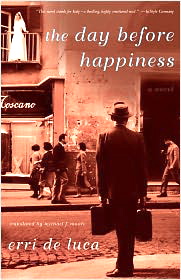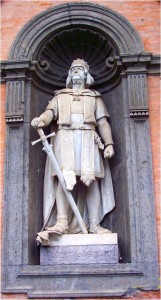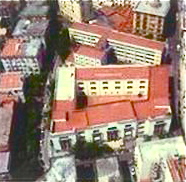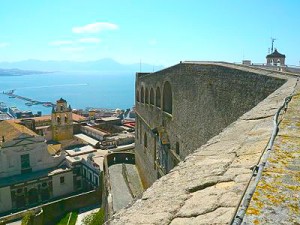“Don Gaetano’s stories were abundant, and they fit inside a single person. He used to say it was because he had lived below, and stories are water that flows to the bottom of the slope. Man is a basin that collects stories – the lower he is, the more he receives.”
 Described by Milan’s daily newspaper Corriere della Serra as “the only true first-rate writer that the new millennium has given us for now,” Erri De Luca writes a story of Naples, and its “persons.” The author has made it clear that you “don’t call them people, they’re persons, each and every one. If you call them people you lose sight of the person. You can’t hear the thoughts of people, [only] of persons.” Here he recreates Neapolitan life, filled with well-developed characters who live through three different time periods – 1943, as Naples has its popular uprising against their German occupiers; the early 1950s, when the unnamed narrator, a young orphan of about seven, is growing up; and the early 1960s, when the young man is now finishing school and about to set out on his own. The novel moves back and forth in time, as the author writes an often lyrical novel full of noble sentiments and wise observations, at the same time that it is packed with details about life and behavior.
Described by Milan’s daily newspaper Corriere della Serra as “the only true first-rate writer that the new millennium has given us for now,” Erri De Luca writes a story of Naples, and its “persons.” The author has made it clear that you “don’t call them people, they’re persons, each and every one. If you call them people you lose sight of the person. You can’t hear the thoughts of people, [only] of persons.” Here he recreates Neapolitan life, filled with well-developed characters who live through three different time periods – 1943, as Naples has its popular uprising against their German occupiers; the early 1950s, when the unnamed narrator, a young orphan of about seven, is growing up; and the early 1960s, when the young man is now finishing school and about to set out on his own. The novel moves back and forth in time, as the author writes an often lyrical novel full of noble sentiments and wise observations, at the same time that it is packed with details about life and behavior.
 The young orphan grows up in the early 1950s without any real supervision. Having never known his parents, he lives in a back room belonging to Don Gaetano, the doorman of an apartment building. The boy is desperate for acceptance into some group, especially the much older soccer players in the neighborhood. His monkey-like ability to retrieve the ball when it goes into balconies and other areas inaccessible to larger children leads to his becoming the goalie of the team, the first real sense of belonging that he has ever had. On one occasion, when the ball goes into the niche behind the statue of St. Ruggiero the Norman in the piazza, the young orphan, crawls inside the niche to discover that there is a secret passageway down into a grotto which he explores. He tells no one. Lovely descriptive passages make the depths of the city, its sponge-like tufo substratum, and its coolness come alive, and when the boy discovers a bed, a Bible, and some books in the secret grotto, he also discovers a whole new world. Often going there to read, starting with The Three Musketeers, left behind by some unknown previous resident, he expands his knowledge through his love of reading and later befriends a seller of used books who allows him to borrow one book a day if he returns it the next day.
The young orphan grows up in the early 1950s without any real supervision. Having never known his parents, he lives in a back room belonging to Don Gaetano, the doorman of an apartment building. The boy is desperate for acceptance into some group, especially the much older soccer players in the neighborhood. His monkey-like ability to retrieve the ball when it goes into balconies and other areas inaccessible to larger children leads to his becoming the goalie of the team, the first real sense of belonging that he has ever had. On one occasion, when the ball goes into the niche behind the statue of St. Ruggiero the Norman in the piazza, the young orphan, crawls inside the niche to discover that there is a secret passageway down into a grotto which he explores. He tells no one. Lovely descriptive passages make the depths of the city, its sponge-like tufo substratum, and its coolness come alive, and when the boy discovers a bed, a Bible, and some books in the secret grotto, he also discovers a whole new world. Often going there to read, starting with The Three Musketeers, left behind by some unknown previous resident, he expands his knowledge through his love of reading and later befriends a seller of used books who allows him to borrow one book a day if he returns it the next day.

Statue of St. Ruggiero the Norman
On another occasion, as the boy is scaling the outside of a house to retrieve a ball, he sees a beautiful young girl through the upstairs window, and he falls instantly in love. When the girl suddenly disappears, Don Gaetano tells him that the girl is not for him. Don Gaetano continues the boy’s education in life, teaching him the competitive and symbolic card game of scopa, which requires its own forty-card deck, a game the boy can never seem to win, and tells him about his life as a priest in Argentina, before he returned to Naples.
The author uses numerous flashbacks to describe wartime life in September, 1943, especially the four days of the uprising which succeeded in driving the nearly-defeated Germans from the city. Beginning with the students at the Liceo Sannazzaro, who set up a blockade against German tanks, the uprising quickly incorporated other men who had been hiding so that they would not be sent to German labor camps. As Don Gaetano emphasizes the lessons he has learned through this and other experiences, he creates a kind of daily catechism of his own, declaring: “There are neither saints nor devils. There are people who perform some good deeds and several evil ones.” “The worst things happen under sunny skies. When the weather is bad, a person prefers to postpone an evil deed.” “A writer has to be smaller than the subject he is describing. You have to sense the story running away from him every which way, and him capturing only a part of it.”

Cards for scopa game
As the novel shifts back and forth among the various time frames, the author reveals information slowly, always showing the concern Don Gaetano has for the boy, though Don Gaetano keeps himself at a distance and never assumes the role of father. He tries to expose the boy to life experiences, taking him on a trip to Ischia and showing him the volcano, teaching him home repairs, arranging for him to spend the day as a fisherman, and finally introducing him to a widow who initiates him into the mysteries of his own body. When the boy is seventeen or eighteen, the beautiful girl, Anna, about whom he has dreamt for years, returns and their meeting becomes the final surprising step in his coming-of-age.

The Liceo Sannazzaro, where the uprising against the Germans took place in 1943
Although the author’s use of time is more modern than that of Ernest Hemingway, the two have much in common in their ability to include much information in few words. The selection of perfect details, rather than numerous details, elevates this short novel to a rare level and provides a platform from which Don Gaetano can expatiate with folk wisdom, based on his own life experiences. The observation that no one in an orphanage has a name – that everyone uses a nickname; that the game of scopa is an almost religious act; that the day before happiness (when bad things often happen) is even more important than the happiness which follows it; that Christianity is like a belt around the world; that heirs get rid of the books accumulated by the dead in order to exorcise their ghosts, and that Naples is “Spanish” (and anarchistic) in tone and is located in Italy “by mistake,” all suggest much more than they actually say, a wonderful change from the overly specific and self-conscious style of much modern writing.

St. Elmo Fortress, where arms were stored
Intense in its imagery and emotion, this novel credits the reader by believing that s/he is capable understanding on a level beyond that of plot, and that the longings of the main character and his search to belong are universal and not limited to this one character in this one set of circumstances and times. The novel excites on the level of theme and style, and it is hard to imagine any reader not responding to the needs of the young orphan with empathy and warmth as he learns to understand people and to “read their thoughts.”
ALSO by De Luca: THREE HORSES
Photos, in order: The author’s photo is from http://www.rottentomatoes.com
The photo of St. Ruggiero the Norman appears here: http://cdd.linternet.com
The unique scopa cards are seen on http://en.wikipedia.org
The Liceo Sannazzaro, where the uprising against the Germans took place in 1943, appears on http://libri.dvd.it
During the war, arms were stored in the old Sant’Elmo Fortress, where they were stolen by partisans. http://en.wikipedia.org
